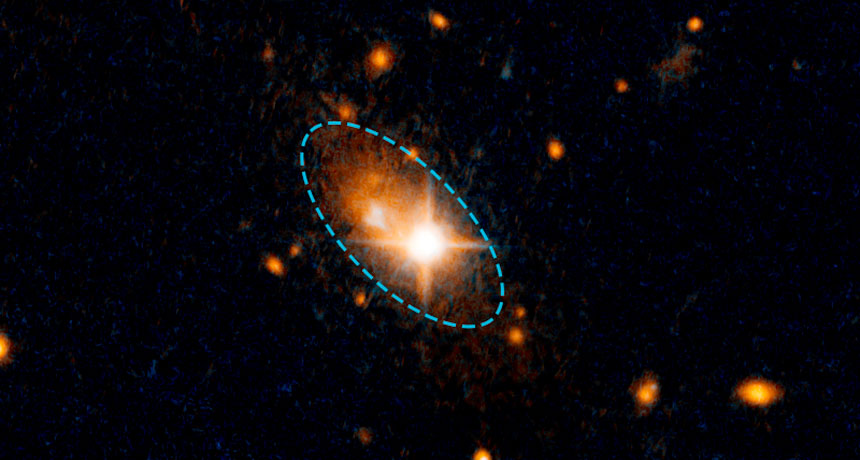Supermassive black hole gets kicked to the galactic curb

A black hole weighing more than a billion suns appears to have gotten the boot toward the outer edges of its galaxy.
Data from the Hubble Space Telescope and other observatories reveal a supermassive black hole zipping away from the center of its galaxy at a 7.5-million-kilometer-per-hour clip. It’s moving so quickly that it could leave the galaxy for good in 20 million years, says Marco Chiaberge of the Space Telescope Science Institute in Baltimore.
Only gravitational waves — ripples in the fabric of spacetime — could give the black hole such a kick, Chiaberge and colleagues report March 30 in Astronomy & Astrophysics. Hints of huge black holes ejected from a galactic center have been reported before (SN: 5/24/08, p. 12). This discovery offers some of the most convincing evidence that black holes can get kicked out of their galaxies by gravitational waves and suggests that it occurs more often than astronomers thought.
“This is a very nice candidate for a recoiling supermassive black hole,” says Francesca Civano of the Harvard-Smithsonian Center for Astrophysics in Cambridge, Mass. Recoiling black holes are created when two monster black holes from different galaxies merge, says Civano, who was not involved in the new study. If the black holes have different masses and rotate at different rates, the collision can generate gravitational waves more strongly in one direction, booting the newly merged black hole the other way.
A radiation-gushing supermassive black hole called quasar 3C 186 and its host galaxy, about 8 billion light-years from Earth in the constellation Lynx, tipped off Chiaberge and colleagues to the recoiling black hole. The team noticed that the quasar wasn’t at the center of the galaxy, where it typically should be. “We knew this was clearly weird. It was clearly different than all of the other quasars and galaxies we were seeing,” Chiaberge says.
The team calculated that the quasar was 35,000 light-years from its host galaxy’s center — about 10,000 light-years more than the distance separating the sun and the center of the Milky Way. 3C 186 is a well-studied object, so the team sifted through past observations of the quasar and galaxy and found data revealing how fast the gas surrounding the monster black hole moves. The researchers compared it with how fast the star-forming gas in the galaxy moves. The monster black hole was traveling much more quickly, with a velocity that would have to come from something forceful, equivalent to 100 million stars exploding simultaneously. Gravitational waves could provide such a kick.
The Hubble images also revealed curved wisps of stars and gas extending from the galaxy. Such faint tails suggest that the galaxy collided with another galaxy in the past, giving weight to the team’s claim that gravitational waves from colliding black holes could have given 3C 186 its kick.
Evidence of recoiling black holes is hard to find, but it’s the easiest explanation for the data in the new paper, Civano says. The new work, she notes, also suggests recoiling black holes could be more common than astronomers thought, but missed in earlier observations. “They might just be hidden in well-known sources, like 3C 186,” she says.